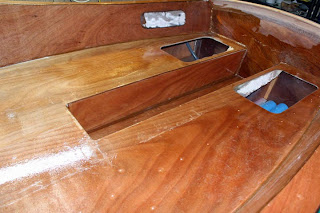Toerails are needed along the sides of the cabin deck because access to the front compartment (anchor well) is sometimes needed while on the water. The toerails are there to help keep you from falling in. Here are the toerails being glued in place. The anchor well is to the left.
 |
| Toerails Gluing |
Builders please take note: The plans show the toerails beveled equally on each side, but if you look at the picture in the manual you will see that one side is at a 90-degree angle and the other side is beveled. I noticed this too late, but I think it would have worked better. That is, the perpendicular side would be inboard and give more purchase, while the beveled side (outboard) would be more beveled and closer to being parallel with the hull at that point. As I say, I noticed too late, but if you choose to do it according to the picture I think it would be an improvement.
Quite a lot of time has been spent over the past couple days with rub rail and companionway work. The rub rails will be built up with three layers of mahogany strips. I started by cutting strips of 3/4" x 1 1/4, 3/4 x 1 3/32, and 3/4 x 15/16. The rails will be over 16 feet long so I had to glue together two 8-foot lengths and one 4-foot length for each rail strip. Here are the strips clamped and glued:
 |
| Rub-rail Strip Scarfs Gluing |
I used what is called a scarf joint to attach the pieces together. This is done by cutting long bevels on the ends to be glued. A 10:1 scarf is called for, so I made 8 1/2" long scarfs along the 3/4" width of each piece. Here is a closeup of some of the scarf joints:
 |
| Closer Shot of Scarf Joints |
The easiest way to cut the scarfs is to build a simple jig that slots into the tablesaw top, shown here:
 |
| Scarfing Jig |
I guess I should have shown it on the saw itself, it's function would have been much clearer. Anyway there is a strip of wood on the bottom that holds the jig in alignment as it slides along the saw table. The strip of wood on the top is at a 6-degree angle and the piece to be scarfed is clamped to it and sawn.
Next the rub-rail strips will be beveled on each side and glued to the boat, one at a time. That will be shown in a later post.
While the rub-rail strips are curing I have begun work on the companionway opening. The first step is to glue a plywood insert to the inside of the rear cabin wall, as shown here:
 |
| Companionway Insert and Sills Gluing |
Before that is glued in though, the bottom of the cabin wall is beveled downward so water doesn't stand there.
Next, sills are made for the top of the opening and glued in place:
 |
| Companionway Sills Gluing |
While all that cures I'll be working on the companionway hood and slide. All of this will form a system that is supposed to keep rainwater out of the cabin. I have read reports by other builders and they all say their cabins stay remarkably dry (unless they forget to close the hatches).



















